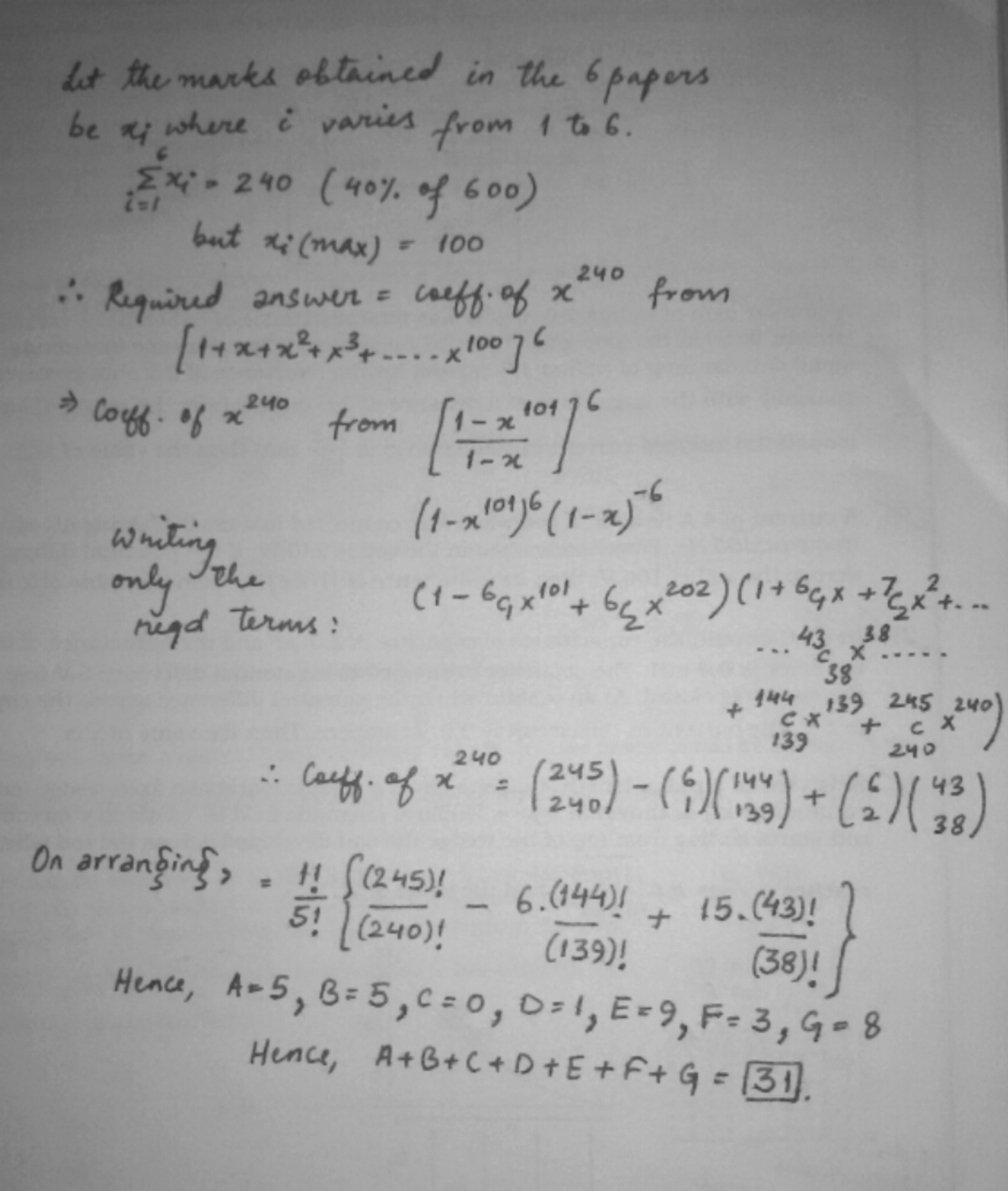Method to obtain 40%
In a certain examination 6 papers are set , and to each are assigned 1 0 0 marks as a maximum. The number of ways in which a candidate may obtain 4 0 % of the whole marks is A ! 1 ! { ( 2 4 C ) ! ( 2 4 B ) ! − 6 . ( 1 3 E ) ! ( D 4 4 ) ! + 1 5 . ( 3 G ) ! ( 4 F ) ! } Find the value of A + B + C + D + E + F + G
Details and Assumptions :
A , B , C , D , E , F , G are digits from 1 to 9
The answer is 31.
This section requires Javascript.
You are seeing this because something didn't load right. We suggest you, (a) try
refreshing the page, (b) enabling javascript if it is disabled on your browser and,
finally, (c)
loading the
non-javascript version of this page
. We're sorry about the hassle.
2 solutions
Lost 4 0 0 points just because of a silly mistake. The general term for ( 1 − x ) − n is ( r n + r − 1 ) but I took it to be ( r − 1 n + r − 1 )
Thanks @Danish Mohammed for the solution
You must write that the variables are digits from 0 to 9 not 1 to 9 as C=0. I got a little confused when I got C=0 and checked my method twice.

Here's my solution
Let the marks scored in the i th paper be x i for i = 1 , 2 , 3 , 4 , 5 , 6
Then we have x 1 + x 2 + x 3 + x 4 + x 5 + x 6 = 2 4 0 since 240 is 40% of the total marks (600)
We also have the constraints 0 ≤ x i ≤ 1 0 0 for i = 1 , 2 , 3 , 4 , 5 , 6
I denote the coefficient of x r as ( ( x r ) ) and the binomial coefficient as C ( n , r ) = r ! ( n − r ) ! n !
Now the number of integral solutions of the equations with the constraints is
( ( x 2 4 0 ) ) in ( 1 + x + x 2 + x 3 + ⋯ + x 1 0 0 ) 6
= ( ( x 2 4 0 ) ) in ( 1 − x 1 0 1 ) 6 ( 1 − x ) − 6 using the formula for the sum of a geometric sequence
= ( ( x 2 4 0 ) ) in ( C ( 6 , 0 ) − C ( 6 , 1 ) x 1 0 1 + C ( 6 , 2 ) x 2 0 2 ) ( 1 − x ) − 6 . Using the binomial theorem. The powers greater than 240 can be left out since they do not contribute to the coefficient
= ( ( x 2 4 0 ) ) in C ( 6 , 0 ) ( 1 − x ) − 6 − ( ( x 1 3 9 ) ) in C ( 6 , 1 ) ( 1 − x ) − 6 + ( ( x 3 8 ) ) in C ( 6 , 2 ) ( 1 − x ) − 6
= C ( 6 , 0 ) C ( 2 4 5 , 2 4 0 ) − C ( 6 , 1 ) C ( 1 4 4 , 1 3 9 ) + C ( 6 , 2 ) C ( 4 3 , 3 8 ) from the binomial theorem for a negative power
Simplifying we get, the number of ways
= 5 ! 1 ! ( 2 4 0 ! 2 4 5 ! − 6 1 3 9 ! 1 4 4 ! + 1 5 3 8 ! 4 3 ! )
And we get A = 5 , B = 5 , C = 0 , D = 1 , E = 9 , F = 3 , G = 8
and A + B + C + D + E + F + G = 3 1
This is solution uses a technique of associating the coefficients of a series with a combinatorial meaning.
This problem might be solved using the inclusion and exclusion principle, however, I haven't been able to think of how to do this :( If somebody does, please post the solution as I'd love to know how to use the inclusion and exclusion principle. :)